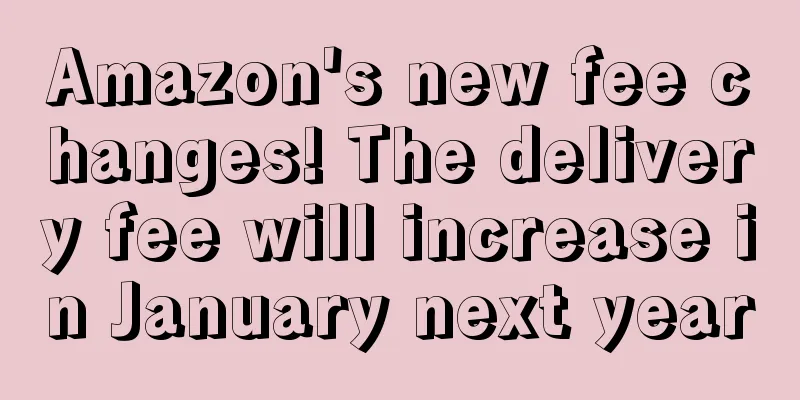Amazon's new fee changes! The delivery fee will increase in January next year

|
A few days ago, Amazon released the latest fee change announcement, stating that it will adopt the latest MCF delivery fee from January 19 next year. In this adjustment of MCF (Multi-Channel Fulfillment), sellers will be provided with upgraded delivery time services, with the standard delivery speed increased from 7 days to 5 days. After the official adjustment in January next year, Amazon will also provide three different delivery time options for sellers: 5-day delivery, 3-day delivery, and 2-day delivery, to meet the different time requirements of multi-channel sellers. However, this change cancels the ultra-lightweight pricing for products weighing less than 2 ounces , and products weighing less than 2 ounces will be merged into the same group of charging standards for products weighing 6 ounces or less. This also causes the cost of products of this size to increase the most. Taking standard parts as an example, the delivery fee for a single product weighing less than 2 ounces is currently $4.75; after the new policy is implemented in January 2023, the product will be merged into the 6oz fee, which is $7.15, an increase of $2.40, an increase of nearly 50% . Secondly, Amazon cancelled the charging standard for 5+ oz and changed it to start charging from 4. Taking the standard item as an example, the delivery fee for a single 6 oz order is now $5.35; after the new policy is implemented, it will be $7.15, an increase of $1.80, or about 33.6%. The above two billing stage changes are the largest part of the fee increase, and the other billing stage increases range from 10% to 20%. In short, the general increase in multi-channel delivery fees is quite exaggerated, almost two or three times the normal increase in FBA delivery fees in previous years. Although Amazon claims that the logistics and delivery fees it provides are lower than those of its competitors, the data I collected from the Internet shows that the latest price increase for USPS is an average of 5.5%, while UPS and FedEx will also have freight rate adjustments of around 6.9% next year . These adjustments are the latest changes that will take effect within a month. It can be seen that the increase is much lower than that of Amazon. Amazon’s repeated price increases have actually seriously affected the competitiveness of products on the platform. This year, it has used peak season surcharges, fuel and inflation surcharges, etc., to increase transportation costs again and again. Many third-party sellers have to raise prices to ensure profits. This year’s Black Friday Cyber Monday survey also showed that consumers are becoming more and more dissatisfied with the prices of online products, believing that the gap between online and offline products is no longer wide, and it is better to go to offline supermarkets with better after-sales and pre-sales experience. This is also one of the important factors that affected Amazon’s Black Friday Cyber Monday sales performance this year. The overall environment of Amazon next year will still be very severe. Everyone must make multiple preparations, look at other emerging blue ocean platforms, and plan and occupy positions in advance. |
<<: Amazon's sales have been cut in half! Will sales continue to shrink next year?
Recommend
What is WHLESS? WHLESS Review
WHLESS is committed to providing software services...
The seller was copied by others on the second day after the sales hit the market. He received 8 emails from the devil and had no choice but to close the store...
<span data-shimo-docs="[[20,"“群里有赶跟卖的吗?”&q...
What is Ouke Cross-border? Ouke Cross-border Review
Shenzhen Ouke Cross-border Supply Chain Co., Ltd. ...
What is Dongguan Kuainiu International Freight Forwarding Co., Ltd.? Dongguan Kuainiu International Freight Forwarding Co., Ltd. Review
Dongguan Kuainiu International Freight Forwarding ...
American retailers have received good news one after another. Who will be the winner this holiday season?
<span data-docs-delta="[[20,"获悉,2022年的黑五、网...
What is Zhenzhen Haitao? Zhenzhen Haitao Review
Zhenzhen is a mobile Internet product under Zhenzh...
Sales of key categories slow down! Best Buy enters multiple new areas to seize market share!
It is learned that Best Buy has expanded new sales...
Violating US regulations! The United States officially released a report accusing Temu
Recently, the U.S. House of Representatives offici...
U.S. holiday season consumer data released, online spending reached $221.8 billion
It is learned that according to foreign media repo...
Seize the $1.05 trillion U.S. e-commerce market! You must know these trends
According to the latest research from eMarketer, a...
As wildfires continue to rage in the western United States, will sellers see a turnaround in sales?
<span data-shimo-docs="[[20,"今年以来,美国由于疫情、暴...
The wave of product returns in the US is coming! Is there a mystery behind it?
There have been a lot of things happening in the U...
Don’t touch these “bloody” categories on Amazon!
In 2024, when people discuss which categories are ...
Macy's and Nordstrom's online sales decline as U.S. consumer demand slumps
It is learned that on March 3, Macy's and Nord...
What is DSR? DSR Review
In addition to leaving credit ratings (positive, n...









